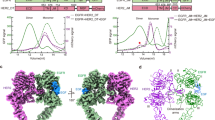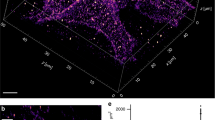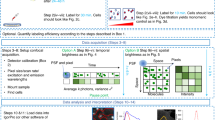Abstract
The early events in signal transduction from the epidermal growth factor (EGF) receptor (EGFR) are dimerization and autophosphorylation of the receptor, induced by binding of EGF. Here we observe these events in living cells by visualizing single molecules of fluorescent-dye-labelled EGF in the plasma membrane of A431 carcinoma cells. Single-molecule tracking reveals that the predominant mechanism of dimerization involves the formation of a cell-surface complex of one EGF molecule and an EGFR dimer, followed by the direct arrest of a second EGF molecule, indicating that the EGFR dimers were probably preformed before the binding of the second EGF molecule. Single-molecule fluorescence-resonance energy transfer shows that EGF–EGFR complexes indeed form dimers at the molecular level. Use of a monoclonal antibody specific to the phosphorylated (activated) EGFR reveals that the EGFR becomes phosphorylated after dimerization.
This is a preview of subscription content, access via your institution
Access options
Subscribe to this journal
Receive 12 print issues and online access
$209.00 per year
only $17.42 per issue
Buy this article
- Purchase on Springer Link
- Instant access to full article PDF
Prices may be subject to local taxes which are calculated during checkout







Similar content being viewed by others
References
Funatsu, T., Harada, Y., Tokunaga, M., Saito, K. & Yanagida, T. Imaging of single fluorescent molecules and individual ATP turnovers by single myosin molecules in aqueous solution. Nature 374, 555–559 (1995).
Weiss, S. Fluorescence spectroscopy of single biomolecules. Science 283, 1676–1683 (1999).
Tokunaga, M., Kitamura, K., Saito, K., Hikikoshi-Iwane, A. & Yanagida, T. Single molecule imaging of fluorophores and enzymatic reactions achieved by objective-type total internal reflection fluorescence microscopy. Biochem. Biophys. Res. Commun. 235, 47–53 (1997).
Yarden, Y. & Schlessinger, J. Epidermal growth factor induces rapid, reversible aggregation of the purified epidermal growth factor receptor. Biochemistry 26, 1443–1451 (1987).
Yarden, Y. & Schlessinger, J. Self-phosphorylation of epidermal growth factor receptor: evidence for a model of intermolecular allosteric activation. Biochemistry 26, 1434–1442 (1987).
Chung, C., Sciaky, N. & Gross, D. J. Heterogeneity of epidermal growth factor binding kinetics on individual cells. Biophys. J. 73, 1089–1102 (1997).
Carraway, K. L. III & Cerione, R. A. Comparison of epidermal growth factor (EGF) receptor-receptor interactions in intact A431 cells and isolated plasma membrane. J. Biol. Chem. 266, 8899–8906 (1991).
Schütz, G. J., Schindler, H. & Schmidt, T. H. Single-molecule microscopy on model membranes reveals anomalous diffusion. Biophys. J. 73, 1073–1080 (1997).
Ide, T. & Yanagida, T. An artificial lipid bilayer formed on an agarose-coated glass for simultaneous electrical and optical measurement of single ion-channels. Biochem. Biophys. Res. Commun. 265, 595–599 (1999).
Azevedo, J. R. & Johnson, D. A. Temperature-dependent lateral and transverse distribution of the epidermal growth factor receptor in A431 plasma membranes. J. Memb. Biol. 118, 215–224 (1990).
Zidovetzki, R., Yarden, Y., Schlessinger, J. & Jovin, T. M. Microaggregation of hormone-occupied epidermal growth factor receptors on plasma membrane preparations. EMBO J. 5, 247–250 (1986).
Gadella, T. W. J. Jr & Jovin, T. M. Oligomerization of epidermal growth factor receptors on A 431 cells studied by time-resolved fluorescence imaging microscopy. A stereochemical model for tyrosine kinase receptor activation. J. Cell Biol. 129, 1543–1558 (1995).
den Hartigh, J. C., van Bergen en Henegouwen, P. M., Verkleij, A. J. & Boonstra, J. The EGF receptor is an actin-binding protein. J. Cell Biol. 119, 349–355 (1992).
Wiegant, F. A. C. et al. Epidermal growth factor receptors associated to cytoskeletal elements of epidermoid carcinoma (A431) cells. J. Cell Biol. 103, 87–94 (1986).
Ishii, Y., Yoshida, T., Funatsu, T., Wazawa, T. & Yanagida, T. Fluorescence resonance energy transfer between single fluorophores attached to a coiled-coil protein in aqueous solution. Chem. Phys. 247, 163–173 (1999).
Kinoshita, K., Itoh, H., Ishiwata, S., Nishizaka, T. & Hayakawa, T. Dual-view microscopy with a single camera: real-time imaging of molecular orientations and calcium. J. Cell Biol. 115,67–73 (1991).
Campos-González, R. & Glenney, J. R. Jr Immunodetection of the ligand-activated receptor for epidermal growth factor. Growth Factors 4, 305–316 (1991).
Pimplikar, S. W., Ikonen, E. & Simons, K. Basolateral protein transport in streptolysin O-permeabilized MDCK cells. J. Cell Biol. 125, 1025–1035 (1994).
Lemmon, M. A. et al. Two EGF molecules contribute additively to stabilization of the EGFR dimer. EMBO J. 16, 281–294 (1997).
Hurwitz, D. R. et al. EGF induces increased ligand binding affinity and dimerization of soluble epidermal growth factor (EGF) receptor extracellular domain. J. Biol. Chem. 266, 22035–22043 (1991).
Sorokin, A., Lemmon, A., Ullrich, A. & Schlessinger, J. Stabilization of an active dimeric form of the epidermal growth factor receptor by introduction of an inter-receptor disulfide bond. J. Biol. Chem. 269, 9752–9759 (1994).
Tzahar, E. et al. Bivalence of EGF-like ligands drives the ErbB signaling network. EMBO J. 16, 4938–4950 (1997).
Sako, Y. & Kusumi, A. Barriers for lateral diffusion of transferrin receptor in the plasma membrane as characterized by receptor dragging by laser tweezers: fence versus tether. J. Cell Biol. 129, 1559–1574 (1995).
Kusumi, A. & Sako, Y. Cell surface organization by the membrane skeleton. Curr. Opin. Cell Biol. 8, 566–574 (1996).
Sako, Y., Nagafuchi, A., Tsukita, S., Takeichi, M. & Kusumi, A. Cytoplasmic regulation of the movement of E-cadherin on the free cell surface as studied by optical tweezers and single particle tracking: corralling and tethering by the membrane skeleton. J. Cell Biol. 140, 1227–1240 (1998).
Carraway, K. L. III, Koland, J. G. & Cerione, R. A. Visualization of epidermal growth factor (EGF) receptor aggregation in plasma membranes by fluorescence resonance energy transfer. Correlation of receptor activation with aggregation. J. Biol. Chem. 264, 8699–8707 (1989).
Acknowledgements
We thank T. Wazawa at the Single-Molecular Processes Project for the computer program with which to measure fluorescence intensity; M. Murata for streptolysin O; and P. Conibear and F. Brozovich for critical reading of the manuscript.
Correspondence and requests for materials should be addressed to T.Y.
Supplementary information is available on Nature Cell Biology’s World-Wide Web site (http://cellbio.nature.com) or as paper copy from the London editorial office of Nature Cell Biology.
Author information
Authors and Affiliations
Supplementary information
Figure 1
Effects of illumination mode on single-molecule imaging. (PDF 100 kb)
Figure 2 Single-molecule FRET from Cy3–EGF to Cy5–EGF.
Rights and permissions
About this article
Cite this article
Sako, Y., Minoghchi, S. & Yanagida, T. Single-molecule imaging of EGFR signalling on the surface of living cells. Nat Cell Biol 2, 168–172 (2000). https://doi.org/10.1038/35004044
Received:
Revised:
Accepted:
Published:
Issue Date:
DOI: https://doi.org/10.1038/35004044
This article is cited by
-
Oligomeric organization of membrane proteins from native membranes at nanoscale spatial and single-molecule resolution
Nature Nanotechnology (2024)
-
Super-resolved FRET and co-tracking in pMINFLUX
Nature Photonics (2024)
-
Confinement of unliganded EGFR by tetraspanin nanodomains gates EGFR ligand binding and signaling
Nature Communications (2023)
-
A method for parallel microscale protein labeling and precise control over the average degree of labeling (aDoL)
Scientific Reports (2023)
-
Imaging strategies for receptor tyrosine kinase dimers in living cells
Analytical and Bioanalytical Chemistry (2023)



